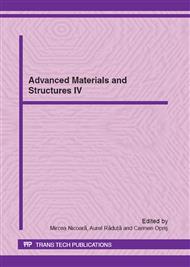[1]
A.R. Pelton, Medical uses of nitinol. Materials Science Forum, Stöckel D & Duerig TW, (2000), P.327-328: 63-70.
DOI: 10.4028/www.scientific.net/msf.327-328.63
Google Scholar
[2]
J.P. O'Leary, et al. The Use of Ni-Ti in the Homer Mammalok, in Engineering Aspects of Shape Memory Alloys, Duerig TW, et al. (eds), Boston, Butterworth-Heinemann, (2005), p.477.
DOI: 10.1016/b978-0-7506-1009-4.50044-5
Google Scholar
[3]
J.Musialek, P.Filip, J.Nieslanik, Titanium-nickel shape memory clamps in small bone surgery. Arch Orthop Trauma Surg (2008), pp.341-344.
DOI: 10.1007/s004020050262
Google Scholar
[4]
Camelia, Szuhanek, T.Fleser, Mechanical Caracteristics for NiTi Wires in Orthodontic Used. Proc. 11th WSEAS Internat. Conf. Iasi, Univ. G.Enescu, Romania, Pages: 44-48, (2010). ISBN 978-960-474-194-6. Publisher: WSEAS Stevens Point, Wisconsin, USA.
Google Scholar
[5]
Camelia, Szuhanek, et al. Numerical analysis of stress and strain distribution during orthodontic treatment with space closure. Proc. Ninth Internat. Conf. New Trends in fatigue and fracture, J. of the Society for Structural Integrity and Life, Beograd, (2009), ISSN1451-3749.
Google Scholar
[6]
Camelia, Szuhanek, et. al. Finite element analysis of stress and strain in orthodontic miniimplants. Proc. Ninth Intern. Conf. New Trends in fatigue and fracture, Journal of the Society for Structural Integrity and Life, Beograd, (2009), ISSN1451-3749.
Google Scholar
[7]
Camelia, Szuhanek, et al. Numerical analysis of mechanical stress induced by orthodontic forces in root apex. UPT Scientific Bull., Mech. Serie, fasc. 1, (2009), p.63–67, ISSN 1224-6077.
Google Scholar
[8]
C.Bertrand, C.Y.Le Petitcorps, Y.L. Albingre, L. The laser welding technique applied to the non precious dental alloys. In: Br. Dent J. (2001) Mar 10;190(5), pp.255-257.
DOI: 10.1038/sj.bdj.4800942a
Google Scholar
[9]
S.Prasad, S. Repairing an implant titanium milled framework using laser welding technology: a clinical report. In: Journal Prosthet. Dent. (2009) Apr.,101(4), pp.221-225.
DOI: 10.1016/s0022-3913(09)00037-7
Google Scholar
[10]
C. Bertrand, C.Y. Le Petitcorps, Y. Optimization of operator and physical parameters for laser welding of dental materials. In: Br Dent J. (2004) Apr. 10;196(7), pp.413-418.
DOI: 10.1038/sj.bdj.4811138
Google Scholar
[11]
J. Johannes, Bock, et.al. Fracture strength of different soldered and welded orthodontic joining configurations with and without filling material. In: Journal of Applied Oral Science, vol.16, no.5, Bauru, Sept./Oct. (2008), ISSN 1678-7757.
DOI: 10.1590/s1678-77572008000500005
Google Scholar
[12]
V.Bardeanu, et.al. Using laser to repair partial dentures movable skeletons. Proc. Internat. Conf. TIMA, ISIM Timisoara, iuny (2007).
Google Scholar
[13]
Camelia Szuhanek, Finite element analysis of lingual forces effect in alveolar bone loss cases. In Journal of Lingual News, (2007), may, Volume 5, Number 1, pp.35-39.
Google Scholar
[14]
Camelia Szuhanek, Biomechanical comparison between tipping forces effect in labial and lingual orthodontics. Proc. Cong. Eur. Soc. of Lingual Orthod, Cannes, (2008), 4-8 iulie, pp.245-250.
Google Scholar
[15]
x x x ANSI/ADA Specification No. 32—Orthodontic Wires.
Google Scholar
[16]
x x x ANSI/ADA Specification No. 88—Dental Brazing Alloys.
Google Scholar


